Selective Breeding
This lesson covers:
- How selective breeding works
- What selective breeding is used for
- The drawbacks of selective breeding
Which of these is a characteristic that humans have selectively bred for?
Cows that produce less milk
Wheat plants with smaller grains
Horses that can run faster
|
Which of the following characteristics do humans selectively breed for in plants?
(Select all that apply)
Increased yield
Decreased yield
Better taste
Worse taste
|
What type of variation can be passed on to the next generation?
Genetic variation only
Environmental variation only
Both genetic and environmental variation
|
What effect does selective breeding usually have on variation within a population?
It does affect variation
It decreases variation
It increases variation
|

What is the term used to describe all the genes and their alleles found in a population?
Inbreeding
Gene pool
Chromosome
Phenotype
|
What is the term used to describe the breeding together of closely related individuals?
Inbreeding
Chromosome
Phenotype
Gene pool
|
What are the drawbacks of inbreeding?
(Select all that apply)
It reduces that size of the gene pool
Rare inherited diseases are more likely to appear
The population as a whole will be more at risk of disease
We can select for advantageous traits
|
Describe how the process of selective breeding could be used to increase milk production in a population of cows.
|